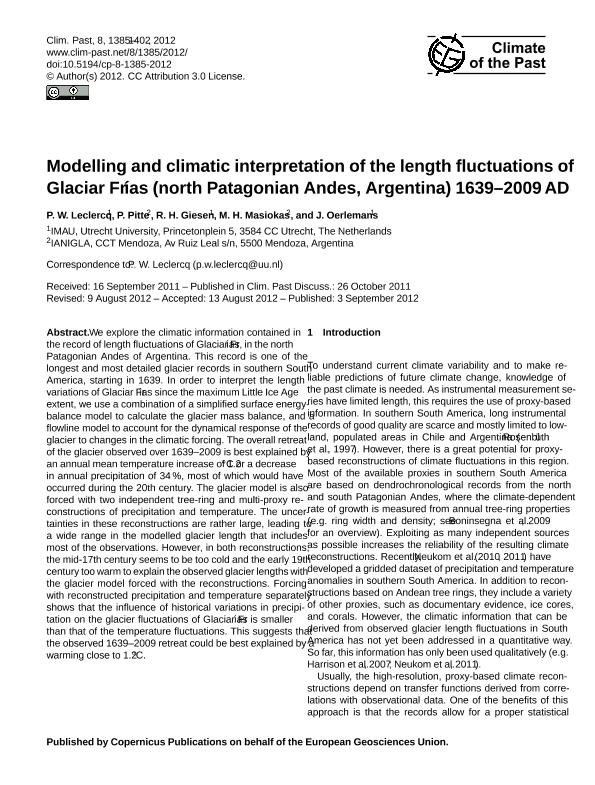Mostrar el registro sencillo del ítem
dc.contributor.author
Leclercq, P. W.
dc.contributor.author
Pitte, Pedro Miguel

dc.contributor.author
Giessen, R. H.
dc.contributor.author
Masiokas, Mariano Hugo

dc.contributor.author
Oerlemans, J.
dc.date.available
2019-03-29T17:40:36Z
dc.date.issued
2012-08
dc.identifier.citation
Leclercq, P. W.; Pitte, Pedro Miguel; Giessen, R. H.; Masiokas, Mariano Hugo; Oerlemans, J.; Modelling and climatic interpretation of the length fluctuations of Glaciar Frías (north Patagonian Andes, Argentina) 1639-2009 AD; Copernicus Publications; Climate Of The Past; 8; 5; 8-2012; 1385-1402
dc.identifier.issn
1814-9324
dc.identifier.uri
http://hdl.handle.net/11336/72843
dc.description.abstract
We explore the climatic information contained in the record of length fluctuations of Glaciar Frías, in the north Patagonian Andes of Argentina. This record is one of the longest and most detailed glacier records in southern South America, starting in 1639. In order to interpret the length variations of Glaciar Frías since the maximum Little Ice Age extent, we use a combination of a simplified surface energy-balance model to calculate the glacier mass balance, and a flowline model to account for the dynamical response of the glacier to changes in the climatic forcing. The overall retreat of the glacier observed over 1639-2009 is best explained by an annual mean temperature increase of 1.2 °C or a decrease in annual precipitation of 34%, most of which would have occurred during the 20th century. The glacier model is also forced with two independent tree-ring and multi-proxy reconstructions of precipitation and temperature. The uncertainties in these reconstructions are rather large, leading to a wide range in the modelled glacier length that includes most of the observations. However, in both reconstructions, the mid-17th century seems to be too cold and the early 19th century too warm to explain the observed glacier lengths with the glacier model forced with the reconstructions. Forcing with reconstructed precipitation and temperature separately shows that the influence of historical variations in precipitation on the glacier fluctuations of Glaciar Frías is smaller than that of the temperature fluctuations. This suggests that the observed 1639-2009 retreat could be best explained by a warming close to 1.2 °C.
dc.format
application/pdf
dc.language.iso
eng
dc.publisher
Copernicus Publications

dc.rights
info:eu-repo/semantics/openAccess
dc.rights.uri
https://creativecommons.org/licenses/by-nc-sa/2.5/ar/
dc.subject
Glacier Model
dc.subject
Glacier Fluctuations
dc.subject
Patagonia Andes
dc.subject
Climate
dc.subject.classification
Meteorología y Ciencias Atmosféricas

dc.subject.classification
Ciencias de la Tierra y relacionadas con el Medio Ambiente

dc.subject.classification
CIENCIAS NATURALES Y EXACTAS

dc.title
Modelling and climatic interpretation of the length fluctuations of Glaciar Frías (north Patagonian Andes, Argentina) 1639-2009 AD
dc.type
info:eu-repo/semantics/article
dc.type
info:ar-repo/semantics/artículo
dc.type
info:eu-repo/semantics/publishedVersion
dc.date.updated
2019-02-06T17:38:51Z
dc.identifier.eissn
1814-9332
dc.journal.volume
8
dc.journal.number
5
dc.journal.pagination
1385-1402
dc.journal.pais
Alemania

dc.journal.ciudad
Gottingen
dc.description.fil
Fil: Leclercq, P. W.. Utrecht Univeristy. Faculty Of Sciences; Países Bajos
dc.description.fil
Fil: Pitte, Pedro Miguel. Consejo Nacional de Investigaciones Científicas y Técnicas. Centro Científico Tecnológico Conicet - Mendoza. Instituto Argentino de Nivología, Glaciología y Ciencias Ambientales. Provincia de Mendoza. Instituto Argentino de Nivología, Glaciología y Ciencias Ambientales. Universidad Nacional de Cuyo. Instituto Argentino de Nivología, Glaciología y Ciencias Ambientales; Argentina
dc.description.fil
Fil: Giessen, R. H.. Utrecht Univeristy. Faculty Of Sciences; Países Bajos
dc.description.fil
Fil: Masiokas, Mariano Hugo. Consejo Nacional de Investigaciones Científicas y Técnicas. Centro Científico Tecnológico Conicet - Mendoza. Instituto Argentino de Nivología, Glaciología y Ciencias Ambientales. Provincia de Mendoza. Instituto Argentino de Nivología, Glaciología y Ciencias Ambientales. Universidad Nacional de Cuyo. Instituto Argentino de Nivología, Glaciología y Ciencias Ambientales; Argentina
dc.description.fil
Fil: Oerlemans, J.. Utrecht Univeristy. Faculty Of Sciences; Países Bajos
dc.journal.title
Climate Of The Past

dc.relation.alternativeid
info:eu-repo/semantics/altIdentifier/url/http://www.clim-past.net/8/1385/2012/cp-8-1385-2012.html
dc.relation.alternativeid
info:eu-repo/semantics/altIdentifier/doi/https://doi.org/10.5194/cp-8-1385-2012
Archivos asociados
